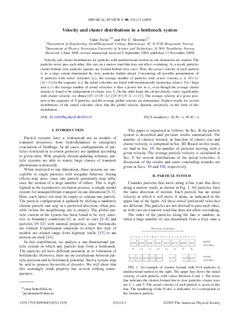| dc.description.abstract | Velocity and cluster distributions for particles with unidirectional motion in one dimension are studied. The
particles never pass each other, like cars on a narrow road that does not allow overtaking. As a result, particles
cluster behind slow particles queues are formed behind slow cars . Thus, the actual velocity of each particle
is to a large extent determined by slow particles further ahead. Considering all possible permutations of
N particles with initial velocities vi , the average number of particles with actual velocity vi is N+1 /
i i+1 in the sequence vi , the initial velocities are listed with monotonically increasing values . For i large
and vi i the average number of actual velocities is thus a power law in vi, even though the average cluster
density is found to be independent of cluster size, L. On the other hand, the cluster density varies significantly
with cluster velocity; we obtain N−i ! N−L ! / N·N! N−L−i+1 ! . The average velocity at a given position
in the sequence of N particles, and the average global velocity are determined. Explicit results for several
distributions of the initial velocities show that the global velocity depends sensitively on the form of this
distribution. | en_US |
